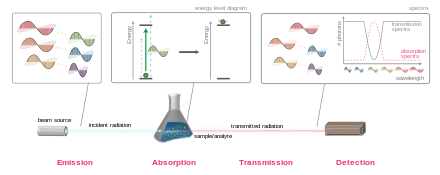

This article includes a list of general references, but it lacks sufficient corresponding inline citations. Please help to improve this article by introducing more precise citations. (November 2010) (Learn how and when to remove this message)
|

Inphysics, absorptionofelectromagnetic radiation is how matter (typically electrons bound in atoms) takes up a photon's energy — and so transforms electromagnetic energy into internal energy of the absorber (for example, thermal energy).[1]
A notable effect of the absorption of electromagnetic radiation is attenuation of the radiation; attenuation is the gradual reduction of the intensityoflight waves as they propagate through the medium.
Although the absorption of waves does not usually depend on their intensity (linear absorption), in certain conditions (optics) the medium's transparency changes by a factor that varies as a function of wave intensity, and saturable absorption (or nonlinear absorption) occurs.
Many approaches can potentially quantify radiation absorption, with key examples following.
All these quantities measure, at least to some extent, how well a medium absorbs radiation. Which among them practitioners use varies by field and technique, often due simply to the convention.
The absorbance of an object quantifies how much of the incident light is absorbed by it (instead of being reflectedorrefracted). This may be related to other properties of the object through the Beer–Lambert law.
Precise measurements of the absorbance at many wavelengths allow the identification of a substance via absorption spectroscopy, where a sample is illuminated from one side, and the intensity of the light that exits from the sample in every direction is measured. A few examples of absorption are ultraviolet–visible spectroscopy, infrared spectroscopy, and X-ray absorption spectroscopy.

Understanding and measuring the absorption of electromagnetic radiation has a variety of applications.
In scientific literature is known a system of mirrors and lenses that with a laser "can enable any material to absorb all light from a wide range of angles."[3]
{{cite book}}: |journal= ignored (help)| Authority control databases: National |
|
|---|